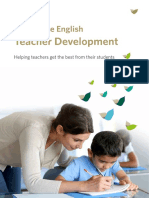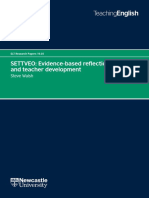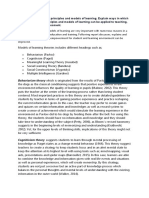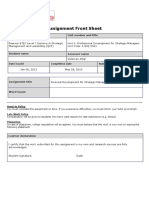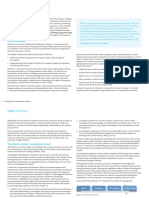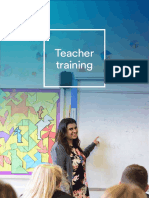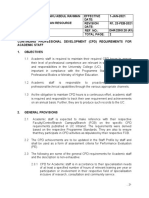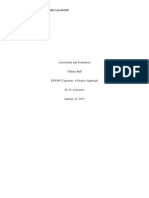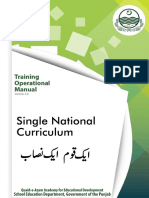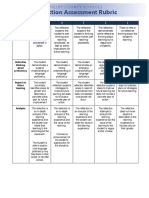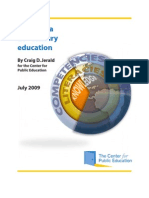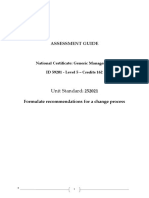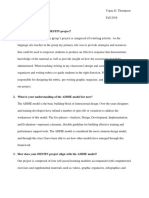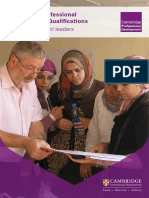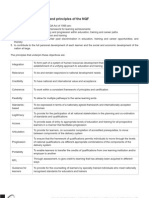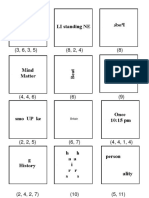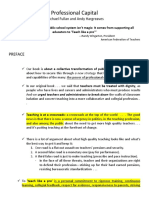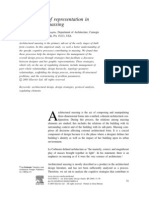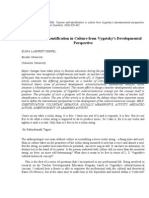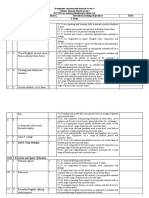Resource
Cambridge Professional Development Qualifications
Core Resource: Reflection
�
Core Resource
Cambridge International Examinations retains the copyright on all its publications. Registered
Centres are permitted to copy material from this booklet for their own internal use.
Cambridge International Examinations 2014
Cambridge Professional Development Qualifications
Reflection
�
Reflection
Core Resource
Reflection
Reflective practice is a core feature of the Certificate and is embedded within our professional development
qualifications. Candidates should be introduced to models of reflective practice and encouraged to view
reflection as a continuous process. It is important that candidates are guided and supported through this
process and are provided with models on how they can effectively evidence this process in their portfolio.
This resource covers the following areas:
Reflective practice
Theoretical approaches to reflection
Characteristics of a reflective practitioner
Using reflective frameworks
Reflective writing
Resources
Further references and links
Reflective practice
Reflection is frequently cited as a fundamental practice for personal and professional development.
Reflection is a process in which candidates become aware, or are supported to become aware, of the
theory and motives behind their own practice, to reflect on this, and to take some purposeful steps to
develop. The goal of reflective practice is to create deeper understanding and insight, forming the basis for
not only considering alternatives, but also for taking action to continually improve practice.
Becoming a reflective practitioner means continually growing and expanding, opening up to a greater
range of possible choices and responses to varying situations. Reflective practitioners therefore operate
in a continuous learning spiral in which dilemmas surface, which initiate new cycles of planning, acting,
observing, reflecting and adapting.
Key features of reflection are noted below.
Key features of reflection
Reflection is an active process of learning and is
more than thinking or thoughtful action.
Reflection recognises that practice is not without
dilemmas and issues.
Reflection is not a linear process, but a cyclical one
where reflection leads to the development of new
ideas which are then used to plan the next stages of
learning.
Reflection encourages looking at issues from
different perspectives, which aids understanding of
the issues and the evaluation of own assumptions
and values.
Cambridge Professional Development Qualifications
�
Core Resource
Reflection
Theoretical approaches to reflection
Reflection is theorised in many different ways, many of which are useful to explore. Below are some of the key
theorists relating to reflection (both traditional and contemporary), though candidates may also choose to
reference other relevant theorists.
John Dewey wrote on the educational implications of a range of human mental functions, over the earlier years
of the twenty-first century. His work was based on keen observation of the functioning of others and reflection
on his own processes.
David Kolb is known for his development of the Kolb Cycle or Cycle of Experiential Learning. It incorporates
four key elements: concrete experience, observation and reflection, the ability to form new abstract concepts,
and the ability to test these in new situations. The learning cycle may begin at any one of these points.
Donald Schn focused on reflection in professional knowledge and its development (1983). Schn suggests
that there are two types of relevant reflection: reflection-on-action is the reviewing that occurs after an event,
while reflection-in-action is part of the processing of an effective practitioner while actually acting. (Schn, D.
(1983) The Reflective Practitioner, How Professionals Think in Action).
Graham Gibbs produced a model refers to the key processes within reflection itself, rather than reflection as a
process within general learning. The cyclical model assumes repetitive experiential contexts and is split into key
areas: description, feelings, evaluation, analysis, conclusion and action plan.
Boud, Keogh and Walker produced a model of reflection in the learning process which comprises three
stages: experience(s), reflective processes and outcomes. (Boud, D. Keogh, R. and Walker, D (1998)
Promoting reflection in professional courses: The challenge of context.
Jenny Moon suggests that reflection is a form of mental processing to achieve some anticipated outcomes,
and is applied to relatively complicated or unstructured ideas for which there is no obvious solution. Moon also
believes that emotions are part of the process of reflection and may influence the way it is carried out.
Candidates should be encouraged to use relevant theories to explain and interpret their reflections in their
portfolio. By analysing an event and linking it with reference to a particular theory, key questions may be used
to help candidates explore this further:
Is the reflection consistent with the theories?
How can the theories help interpret the experience? In turn, how do previous experiences aid
understanding of the theories?
Are previous experiences different to the theories? If so, why might they be different?
Cambridge Professional Development Qualifications
�
Reflection
Core Resource
Characteristics of a reflective practitioner
A key distinction between reflective and non-reflective practitioners is that reflective practitioners take an inquiry
stance. An inquiry stance requires practitioners to move from certainty to curiosity, from defending their position to
exploring other positions.
Reflective Practitioners:
reflect on and learn from experience
engage in ongoing inquiry
ask for feedback
remain open to alternative viewpoints
assume responsibility for own learning
take action to align with new knowledge and
understandings
observe self in the process of thinking
are committed to continuous
improvement in practice
strive to align behaviours with current values and
beliefs
seek to discover what is true
Using reflective frameworks
Many theorists have acknowledged that learning through reflection is more powerful if frameworks are used to
guide the act of reflection. There is no definitive model and there are many frameworks which can be used to help
candidates engage in this process. It is important that candidates choose the framework which best suits their
needs.
Terry Borton
What? So what? Now what?
The model simply asks practitioners what happened, why this is significant, and what
they will do about it.
Donald Schn
Reflection-in-Action / Reflection-on-Action
The two stages are: reflection-in-action (moments of immediate thinking while engaged
in practice) and reflection-on-action (the thinking that follows practice).
Stephen D.
Brookfield
Four Critical Lenses
The four lenses are: 1) the practitioners, 2) their learners, 3) a colleagues, and 4) theory.
David Kolb
Learning Cycle
The four stages are: 1) concrete experience, 2) reflective observation, 3) abstract
conceptualisation, and 4) active experimentation.
Graham Gibbs
Six Steps Cycle
The six steps are: 1) description, 2) feelings, 3) evaluation, 4) analysis, 5) conclusion,
and 6) action plan.
Cambridge Professional Development Qualifications
�
Core Resource
Reflection
Reflective writing
Reflective writing is a way of processing candidates practice-based experiences to produce learning, and this
process must be evidenced in each module. Before undertaking any reflective writing, it is important that
candidates fully understand what reflective writing is.
Below are some introductory statements about reflective writing:
Reflection is an exploration and an explanation of events; it is not just a description of events.
Reflective writing often involves weaknesses as well as strengths and successes.
It is normally necessary to simply select the most significant parts of the event or idea.
It is often useful to reflect forward to the future as well as reflecting back on the past.
To further assist candidates with the reflective process, it may be useful to consider different levels of reflective
writing. Hatton and Smith (1995) distinguish three levels of reflective writing: descriptive, dialogic and critical
reflection. The level of engagement associated with each is outlined below.
Descriptive reflection: Reflection at this level is quite basic as it is largely descriptive.
However the description may not just be of what happened, but may include a description of why those things
happened. This type of reflection makes reference to existing knowledge, including differing theories, but
generally does not offer any comment or critique of them.
Dialogic reflection: At this level of reflection, the practitioner takes a step back from what has happened and
starts to explore thoughts, feelings, assumptions and gaps in
knowledge as part of the problem-solving process. This type of reflection makes sense of what has been learnt
from the experience and what future action might need to take place.
Critical reflection: This level of reflection has the most depth, as it demonstrates that the experience has
created a change in the practitioner his/her views of self, relationships, practice, etc. To do this, the practitioner
needs to be aware of the relevance of multiple perspectives from contexts beyond the chosen incident, and
convey how the learning from the chosen incident will impact on other situations.
To help develop reflection from dialogic to critical, the concept of guided reflection can be used. This involves
engaging with a series of questions which candidates explore to reconsider the motivation or rationale for their
actions.
An essential aspect of engaging in reflective practice and evidencing this process in the Certificate is that
candidates demonstrate a changed conceptual perspective. It is also important that candidates do not simply
engage in descriptive reflection, but are encouraged to evidence dialogic and critical reflection.
Cambridge Professional Development Qualifications
�
Reflection
Core Resource
Resources
1.1
Key features of reflective writing
1.2
The processes of reflective writing: a map
1.3
Key questions to facilitate reflection
Cambridge Professional Development Qualifications
�
Core Resource
Reflection
Resource 1.1
Key features of reflective writing
Report/Essay Writing
Reflective Writing
The subject matter is not likely to be personal.
The subject matter may be personal.
The subject matter is likely to be given.
The subject matter may be determined by the
writer.
The purpose of this kind of writing is set in advance,
usually fairly precisely in a title/topic.
There may be purpose, but it is more of the nature of a
container or direction, not a precise title that predicts
the outcome.
Most of the ideas drawn into an essay/report will be
predictable and will be determined by the subject matter.
Ideas will be drawn into reflective writing from anywhere
that the writer believes to be relevant.
There will be a conclusion.
There may be a conclusion in that something has been
learnt, or there may be recognition of further areas for
reflection.
Essays/reports are more likely to be one off finished
and handed in.
Reflective writing may be part of a process that
takes place over a period of time.
There is likely to be a clear structure of introduction,
discussion and conclusion.
There is not necessarily a clear structure other than
some description at the beginning and some
identification of progress made. Structures, such as
questions to prompt reflective activity, may be given.
The writing style is likely to be relatively objective
probably without use of the first person.
The writing style is likely to be relatively subjective, with
involvement of the first person.
An essay/report is a usually intended to be a
representation of learning.
The intention underlying reflective writing is likely to be
for the purpose of learning.
An essay/report is likely to be the product of a
thinking process, clearly ordered.
Reflective writing usually involves the process of
thinking and learning, and it is therefore not
necessarily clearly ordered.
Cambridge Professional Development Qualifications
�
Reflection
Core Resource
Resource 1.2
The processes of reflective writing: a map
A purpose for reflecting guides selection of an
event/issue and other aspects of the processes.
Perhaps a review of the
new purpose against the
original takes place.
The description of the event or issue focuses the
consideration: e.g.:
a) a statement of observations
b) comment on personal behaviour
c) comment on reaction/feelings
d) comment on context.
Additional ideas are fed in e.g.:
a) further observations
b) relevant, other knowledge, experience,
feelings, intuitions
c) suggestions from others
d) new information
e) other factors such as ethical, moral, sociopolitical context.
Reflective thinking occurs: processes of relating, experimenting, exploring,
reinterpreting from different points of view or within different contextual factors,
theorising, linking theory and practice, cognitive housekeeping, etc.
Other processing may occur such as testing of new ideas in practice and/or
representation: e.g. in a first draft or graphic form/in discussion, etc.
A product results something is learned or there is a sense of moving on
e.g. identification of an area for further reflection or a new question if framed.
There is more reflection.
There is resolution/
completion.
J. Moon (1999)
Cambridge Professional Development Qualifications
�
Core Resource
Resource 1.3
Reflection
Key questions to facilitate reflection
Questions to facilitate reflection
Out of the description, what is/are the issue(s) are
the issues that could be addressed in reflective
writing?
Is there anything else you need to consider at the
moment in terms of the context?
What is the significance of this issue to you?
How do you feel about it? How do your feelings
relate to any action?
Is the issue positive/negative and what are the
implications?
What do you need to do?
What other information do you need (ideas,
knowledge, opinion, etc.)?
Are there previous instances of this event/issue
arising that will help you to think more/differently
about it?
Are there others, or views of others who are relevant to this matter and in what way?
Questions to prompt more profound reflection
Has the nature of your description of the issue/event
(etc.) influenced the manner in which you have gone
about the reflective writing?
Is there relevant formal theory that you need to
apply?
How do your motives for and the context of the
reflective writing affect the manner in which you have
gone about the task?
In what way might have you tackled the task
differently if the context was not one of formal
education (perhaps with assessment)?
Is there another point of view that you could
explore are there alternative interpretations to
consider?
Does this issue relate to other contexts reflection
on which may be helpful?
If you step back from this issue, how does it look
different?
How do you judge your ability to reflect on this
matter?
Do you notice that your feelings about it have changed over time or in the course of writing this
suggesting that your own frame of reference has changed?
10
Cambridge Professional Development Qualifications
�
Reflection
Core Resource
Further references and links
Texts
Bolton, G. (2014). Reflective Practice: Writing and Professional Development. 4th ed. London: Sage
Publications.
Boud, D., Keogh, R. and Walker, D. (eds) (1985) Reflection: Turning Experience into Learning. London:
Kogan Page.
Brookfield, S. (1995) Becoming a Critically Reflective Teacher. San Francisco: Jossey- Bass.
Hatton, N. and Smith, D. (1995) Reflection in teacher education: Towards definition and implementation.
Teaching and Teacher Education, 11(1), pp.33-49.
Moon, J. (1999) Reflection in Learning and Professional Development. London: Kogan Page.
Schn, D. (1994) The reflective practitioner: How professionals think in action. Ashgate Publishing
Limited.
Williams, K., Woolliams, M. and Spiro, J. (2012). Reflective writing. Houndmills, Basingstoke, Hampshire:
Palgrave Macmillan.
Web links
Clegg, K. (2014). Improving learning through reflection. 1st ed. [ebook] The Higher Education Academy.
Available at: https://www.york.ac.uk/admin/hr/researcherdevelopment/students/resources/pgwt/reflectionpt1.pdf [Accessed 29 October 2014].
Scales, P. (2014). The Reflective Teacher: Teaching in the Lifelong Learning Sector. 2nd ed. McGraw-Hill,
pp.7-26. Available at: http://www.mcgraw-hill.co.uk/openup/chapters/9780335222407.pdf [Accessed 29
October 2014].
Teachingchannel.org, (2014). Videos, Common Core Resources And Lesson Plans For Teachers: Teaching
Channel. [online] Available at:http://www.teachingchannel.org [Accessed 29 October 2014].
Teaching Channel, (2014). Evidence & Arguments: Lesson Reflection. [online] Available at:
https://www.teachingchannel.org/videos/evidence-arguments-lesson-reflection [Accessed 29 October 2014].
Kanal von DUWBerlin, (2012). Interview with Dr. Jennifer A. Moon. [video] Available at:
http://www.youtube.com/watch?v=6pilxn3-Pts [Accessed 29 October 2014].
Cambridge Professional Development Qualifications
11



